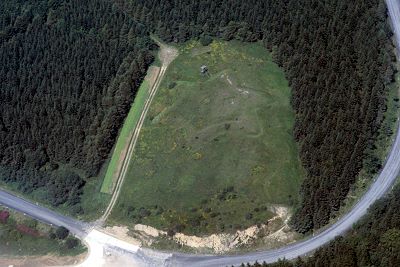It's a throwback to the Thirty Years' War, when Gustavus Adolphus of Sweden marched across Germany like a hot knife through butter. The fort -or its daddy- are first seen in an engraving of the Swedish capture of Donauworth in 1632, the caption suggesting it was built by the Bavarian defenders of the town but abandoned to the Swedes (who are making good use of its command of the city to bomb it to bits).


Gustavus' brief campaign in Germany was methodical, and he built enough forts and outposts guarding his lines of communication that the term Schwedenschanze ("swedes' fort") almost became synonymous with "old fortification" in later years. The four-bastion style seen in the 1632 engraving is typical. Like a lot of siege and fortifying practices of the time it was probably inspired by Dutch efforts, like their little one in Pfaffenmütz dating to 1620:

The Swedes definitely followed the design, for example in Pommerania:

And the were not the only ones, as this detail from an engraving of the siege of Magdeburg in 1631 shows:

Whether Fort Augustus is the original Bavarian fortification or an improved Swedish one built in its place, this Merian engraving from the middle of the 17th century shows it's changed very little:


Moving closer to the time of the battle we are fortunate that in 1696, the Elector of Bavaria Max Emanuel had the bright idea to commission the engraver Michael Wening to produce pictures of his realm. Wening took to the task with gusto, and executed nearly 900 engravings of cities, monasteries and castles in Bavaria. And he made quite a nice one of Donauworth:

You can see that on top of the Schellenberg there are still the visible remains of Fort Augustus, somewhat worn by the passage of time:

The ditch around the fort seems to have disappeared and the bastions' centers have caved, probably the cummulative effect of rain and wind. Still, nothing a bit of work by the city's population cannot mend.
In case someone finds it hard to believe that a fort made of nothing more than packed earth could still be in good shape more than fifty years after it was built, check out this photo of one of the sights in the Rhön mountains in southern Germany:

That polygonal thing? It's the remains of another fort built in Gustavus Adolphus' time, three hundred and seventy years ago.
This is where I got the pics that accompany this little piece:
(most sites are in German)
http://www.rhoenline.de/schwedenschanze.html A brief description and a few more photos of the Rhön fort.
http://vermessung.bayern.de/historisches/historische_ansichten.html Details on Michael Wening's life and work.
http://www.bibliothek.uni-augsburg.de/dda/urn/urn_uba000200-uba000399/uba000236-uba000256/ An amazing, incredible project at the University of Augsburg, where they've digitised and placed online all 21 volumes of Theatrum Europaeum, covering European history from 1618 to 1718, and chock full of engravings, portraits and maps.
http://de.wikisource.org/wiki/Topographia_Bavariae_(Bayern):_Thonauwerd The description of Donauworth in the 1644 work Topographia Bavariae.









